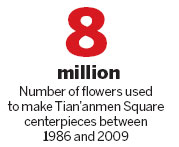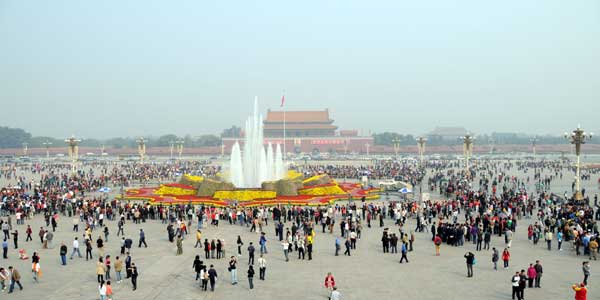Society
Flower power sees Tian'anmen blossom
By Cheng Yingqi and Cao Li (China Daily)
Updated: 2010-09-27 08:29
 |
Large Medium Small |
Blooming marvelous
The display in Tian'anmen Square will be taken down on Oct 15, with the flowers returned to the nurseries where they will be converted into compost or stored until next year. Frames are also often reused.
In the backyard of the Florascape workshop in Shunyi district stood two elephant sculptures that were placed in the Summer Palace last October and will this year adorn Chang'an Avenue.
However, Yan Hongfei, a researcher with the workshop, said redecorating a frame is not an easy job.
A proficient worker can at best insert 1.8 square meters of soil with flowers into a frame in eight hours, he said, explaining that the elephants, both 3 meters tall, have a superficial area of around 10 square meters. Last year, 22 similar plant creations were placed along Chang'an Avenue.
"We usually start making these half-finished sculptures in early August," Yan told China Daily. "We get them ready just before National Day. If we finish too early, we can't ensure they will blossom during the holiday period."
Florascape also grows its flowers at a nursery in Shunyi, which allows them to produce specially selected varieties to meet its requirements. However, in years with severe weather conditions, Lan Hailang said he will often change his design according to the flowers he has available.
"Thanks to decades of experience, we usually know the gross amount of flowers we will need, or at least we're sure how many red, yellow and pink flowers ones we have," he said. "Buying flowers from regions outside of Beijing is not the usual practice because it's more difficult to control their florescence due to different climates."
Horticulturists at the nursery regulate everything from the lighting to the hormones to ensure the flowers bloom at the right time, and will replace plants as soon as they begin to wilt. "If we need 100 pots of flowers, we often transport 150 pots as backup," said Li Qingxia, who was one of 10 engineers in charge of choosing the flowers and plants for this year's centerpiece design.
Despite the advanced technology, though, watering the grand display can still be a problem.
Every year, one of Li's jobs is to teach workers how to use the irrigation devices. She explained that all the potted flowers are fitted with a needle that delivers water to the root, while plug tray structures are fixed with sprays that allow flowers to remain abloom for about 30 days.
Li said she always chooses flowers that are resistant to strong sunlight and rainstorms, such as petunia hybrida, because the autumn weather in Beijing is very capricious.
The display for 2008 posed a difficult challenge, however. Due to Beijing hosting the Olympic Games and the Asia-Europe Summit, the flower terrace was kept on display from July until November.
"In the summer the flowers faced heavy rains and in November the weather was so cold that most flowers withered, meaning we had to use more lighting to create a beautiful effect," she added.



He Na contributed to this story.
